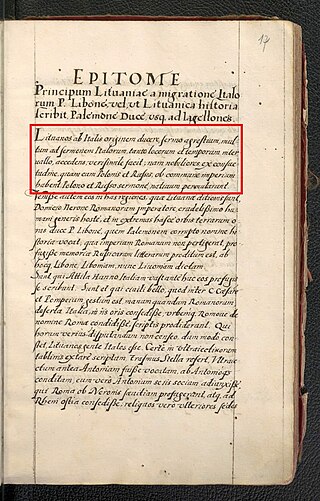Palemonids
Legendary Lithuanian dynasty From Wikipedia, the free encyclopedia
The Palemonids (Lithuanian: Palemono dinastija) were a legendary dynasty of the Grand Duchy of Lithuania. The legend was born in the 15th or 16th century as proof that Lithuanians and the Grand Duchy were of Roman origins.

History
Summarize
Perspective
Jan Długosz (1415–1480) wrote that the Lithuanians were of Roman origin, but did not provide any proof. The legend is first recorded in the second edition of the Lithuanian Chronicles produced in the 1530s.[1] At the time the Grand Duchy of Lithuania was quarrelling with the Kingdom of Poland, rejecting the claims that Poland had civilized the pagan and barbaric Lithuania. The Lithuanian nobility felt a need for the ruling dynasty to show upstanding origins, as the only available chronicles at the time were written by the Teutonic Knights, a long-standing enemy, and depicted Gediminas, ancestor of the Gediminids dynasty, as a hostler of Vytenis.[2]
In this new Lithuanian chronicle, Palemon (sometimes identified as Polemon II of Pontus), a relative of Roman emperor Nero, escaped Rome together with 500 noble families. The company traveled north, through the Baltic Sea, and reached the Nemunas Delta. After that they decided to sail upstream until they reached the mouth of Dubysa. There, the Palemonids settled on a large hill (now known as the Palemon Hill) and ruled the country for generations until the Gediminids emerged.[1] The chronicle skipped Mindaugas and Traidenis, attested Grand Dukes of Lithuania, entirely.[2] It incorporated the account of the Gediminid line from the first edition. To make the story more believable, the chronicler presented a very detailed account of the journey. Because there were not enough generations to cover the gap between the 1st century when Palemon arrived and the 14th century when Gediminas died, the third edition of the chronicle, also known as the Bychowiec Chronicle, placed Palemon in the 5th century instead of the 1st, when Rome was devastated by Attila the Hun,[1] and included Mindaugas and other attested dukes. But it was not enough and historians like Maciej Stryjkowski and Kazimierz Kojałowicz-Wijuk moved the account further, into the 10th century.[3] Multiple contradictory versions of the legend survive to this day as historians tried to patch up some obvious mistakes and make it more historically sound.
The first to critically evaluate and reject the legend was historian Joachim Lelewel in 1839.[4] At the end of the 19th century there were some attempts, for example in a history written by Maironis, to tie the legend with the expansion of the Vikings.[1] While many historians up until the dawn of the 20th century believed the legend to be true, it is now largely discarded as a fictional story that only serves to illustrate political ideology in the 16th-century Lithuania.[5]
A neighborhood in Kaunas is named after Palemonids – Palemonas.
Genealogical tree according to the second edition of the Lithuanian Chronicles
Summarize
Perspective
| Palemon Polemon II of Pontus, or in alternative versions hailing from the Colonna family or from Republic of Venice | ||||||||||||||||||
| Borkus Duke of Samogitia Founder of Jurbarkas |
Kunos Duke of Aukštaitija Founder of Kaunas |
Spera Duke of Eastern Lithuania Name: Lake Spėra | ||||||||||||||||
| Daumantas Duke of Deltuva From Centaurus family |
Kernius Duke of Lithuania Founder of Kernavė |
Gimbutas Duke of Samogitia | ||||||||||||||||
| Montvilas Duke of Samogitia | ||||||||||||||||||
| Kiras Duke of Deltuva |
Pajauta ♀ Name: valley in Kernavė |
Nemunas Name: Nemunas |
Erdvilas Duke of Naugardukas |
Skirmantas | Vykintas Duke of Samogitia | |||||||||||||
| Mingaila Duke of Naugardukas and Polockas |
Živinbudas Duke of Samogitia | |||||||||||||||||
| Kukovaitis Duke of Lithuania |
Skirmantas Duke of Naugardukas, Pinsk, Turov, etc. |
Ginvilas Duke of Polockas |
Kukovaitis Duke of Samogitia | |||||||||||||||
| Traidenis Grand Duke of Naugardukas |
Liubartas Grand Duke of Karachev |
Pisimantas Duke of Turov |
Rogvolodas Duke of Polockas | |||||||||||||||
| Algimantas Duke of Naugardukas |
Gleb Duke of Polockas |
Paraskeva ♀ | ||||||||||||||||
| Utenis Duke of Lithuania and Samogitia Founder of Utena |
Ryngold Duke of Naugardukas | |||||||||||||||||
| Vaišvilkas Duke of Naugardukas | ||||||||||||||||||
| Šventaragis Grand Duke of Lithuania Name: valley in Vilnius | ||||||||||||||||||
| Skirmantas Grand Duke of Lithuania | ||||||||||||||||||
| Trabus Duke of Samogitia |
Koliginas Duke of Lithuania and Rus' | |||||||||||||||||
| Romanas Grand Duke of Lithuania | ||||||||||||||||||
| Narimantas Grand Duke of Lithuania |
Daumantas | Olshan Ancestor of Alšėniškiai |
Giedrius Ancestor of Giedraitis family |
Traidenis Grand Duke of Lithuania | ||||||||||||||
| Rimantas Grand Duke of Lithuania | ||||||||||||||||||
| Source: Jučas, Mečislovas (2003). Lietuvos metraščiai ir kronikos (in Lithuanian). Vilnius: Aidai. p. 53. ISBN 9955-445-40-8. The table was prepared according to the second edition of the Lithuanian Chronicles, the so-called transcription of the Archaeological Society. Other editions, transcriptions, chronicles, and later historians presented significantly different genealogical trees.
Note: Darker shaded cells represent dukes who share their names with real historical figures. Dukes with the title Grand Duke of Lithuania ruled the unified country: i.e. they ruled Lithuania, Samogitia, and Rus'. | ||||||||||||||||||
See also
References
Wikiwand - on
Seamless Wikipedia browsing. On steroids.
